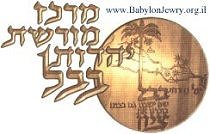Outrage: U.S. Returning Artifacts Looted from Iraqi Jews to Iraq, Instead of Lawful Owners
P.J Media
Like returning artifacts to Germany, had they never renounced Nazism. This following a heroic effort to save them by Dick Cheney, Natan Sharansky, Richard Perle, and me, among others.
By Harold Rhode
August 26, 2013
The National Archives is readying an exhibit of Iraqi Jewish artifacts due to open on October 11. Appallingly, the U.S. government has agreed to then return the Iraqi Jewish archives — including holy books — to Iraq, which systematically expelled its Jewish community, by June of 2014.
How did the Jewish Iraqi community — which dates to 721 B.C.E. when the Assyrians conquered Samaria and eventually deported the population to central Mesopotamia, and which was one of the two main sources of Mishnaic and Talmudic learning — lose, find, and lose again its patrimony?
The incredible story of how this unlikely turn of events came to pass has never been told in its entirety until now; I am one of the few who can tell it.
After American forces entered Baghdad in May 2003, the head of the Jewish and Israel section of Saddam Hussein’s Mukhabarat (intelligence agency) came to the Iraqi National Congress (INC), offering information about Saddam’s intelligence operations against Israel and Jews. He did this in order to curry favor. Former Iraqi officials frequently came to opposition groups to tell their stories, in return for which they would get “safe passage” documents stating that since they were cooperating with post-Saddam authorities, they should not be harmed.
The tipster visited the INC to talk about the rumored Jewish archives hidden in the basement of the Mukhabarat headquarters. After his visit, INC chairman Ahmed Chalabi called Judy Miller, the former New York Times reporter then embedded with a mobile unit looking for WMD, and me. I was an Arabic/Hebrew speaking policy analyst with the Office of Net Assessments in the Office of the Secretary of Defense, then assigned to the Coalition Provisional Authority, at the time.
We rushed over to talk with Chalabi, who told us that a former Mukhabarat employee reported that a huge treasure trove of Iraqi Jewish and Israeli material was amassed in the Mukhabarat building, and that he was prepared to show us where it was located. He also said there was an ancient copy of the Talmud written on leather or parchment.
Miller and I then went off to the Mukhabarat building with the former Saddam officer and an INC contingent.
The tipster indicated from outside the building where in the basement the Jewish and Israel sections were located. Then — he promptly disappeared. Despite the bombed-out structure’s instability, looters were overrunning the building. Danger was everywhere.
We were, in fact, standing beside a large metal device which had lodged itself halfway into the ground. We later learned that this live, undetonated bomb had penetrated through three or four stories of the building and destroyed the building’s water system. It had pierced the wall almost at ground level. We saw, through the hole it made, that the Jewish and Israel sections were flooded.
We went around to the building’s main entrance and descended only halfway down a basement staircase, blocked by water which had risen about halfway up. Several WMD team members waded into the water and entered the Israel section. They found pictures of the Dome of the Rock, a Soviet map of Israel’s Dimona nuclear reactor, and a sign in Arabic which read: “Who will be the one to send the 40th missile to Israel?” (This referred to the fact that during the Kuwait war, Iraq had sent 39 missiles toward Israel.)
The WMD team then proceeded down the hall, found the Jewish section, and carried out religious books and a tiq (the wooden/metal box which holds Torahs). These items proved to be only a tiny example of what we were to find later.
Many Iraqis with whom we spoke about the discovery told us to get the material out of the country as soon as possible before it became public knowledge. That way, Iraqi Jewry could have its patrimony, and no Iraqi politician could be held responsible for having let the Jews take the material.
But that was not so simple. Almost all of the material was under water, and whatever its long-term fate, it had to first be rescued and salvaged. We therefore needed drainage pumps so we could get to the items, and we needed manpower to take the material out, and we needed money to pay for both and had no access to either.



